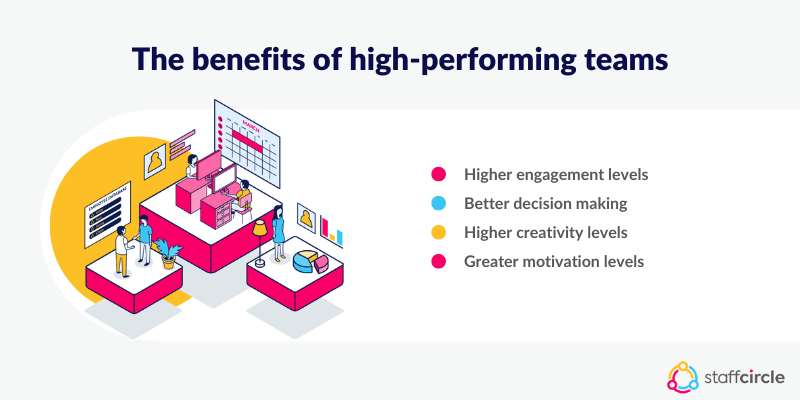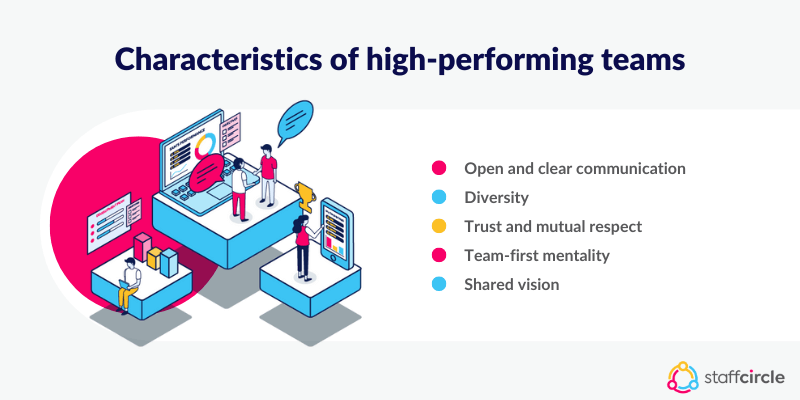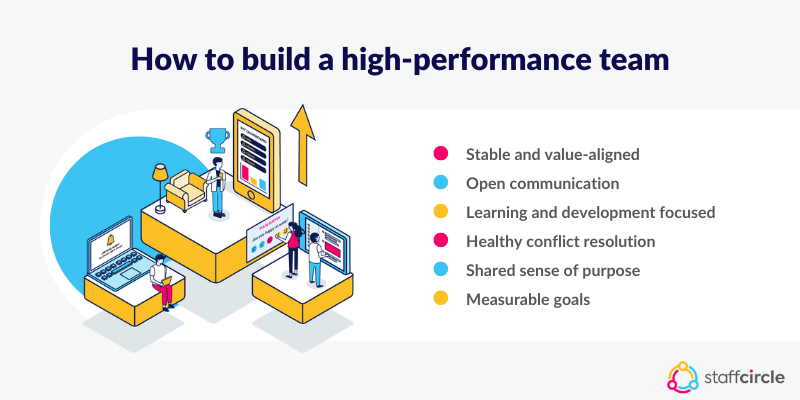High-performing teams are defined by a set of characteristics that include exceptional communication skills, high levels of trust, and a desire to innovate. But what makes a high-performing team?
Read on to find out how you can create the environment and mindset where high-performance teams are able to flourish and excel in their tasks.
What is the definition of a high-performing team?
High-performing teams are teams that are capable of delivering outstanding results in a timely manner. Such teams are typically composed of diverse employees with a broad range of complementary skills, which, when brought together, fosters an environment of intense collaboration and innovation.
The study from Deloitte discussing the qualities required for high-performance teams states the following:
“Today’s business teams—like the teams in a cycling peloton—need to be autonomous, adaptable, disciplined, productive, and continually improving how they deliver results, as well as intrinsically connected to the work of other teams across the organization.”
Such teams can be put together by using performance management software to identify those employees with the relevant skills and experience to play a given role. These tools can also help develop the necessary skills and nurture the core characteristics and behaviours required by the best teams.
What are the benefits of high-performing teams?
Putting together high-performing teams confers a wide range of benefits to an organisation.

These benefits include:
- Higher levels of engagement. High-performance teams are noted for their cohesive structure in which each member consistently engages with their peers.
- Better decision-making. With more competent individuals involved in decision-making and a broader selection of experience and skills to draw from, high-performance teams solve problems with greater success.
- Higher levels of creativity. Individuals working in high-performance teams with highly qualified colleagues are more adept at lateral thinking. This out-of-the-box mentality allows for more creative solutions to the challenges they face.
- Greater levels of motivation. Individuals who are surrounded by intelligent colleagues with solid communication skills are more motivated to succeed. When employees see those around them working hard and with enthusiasm, it motivates them to behave in a similar manner.
What are the 5 most important characteristics of high-performing teams?
Understanding the most important characteristics of high-performing teams gives a clear insight into what factors to replicate to create your own high-performance teams. Implement these five characteristics to help deliver outstanding team performance.
Open and clear communication
Poor communication is one of the most common obstacles for high-performing teams, with crossed wires and misunderstandings leading to unnecessary errors. The best teams are those who establish clear lines of communication while also adopting a philosophy of continual conversations to guarantee clarity and focus.
They use a multi-channel communications platform so that each team member is able to receive communications wherever they are. Such platforms can be set up to send messages via email, SMS text messaging to mobile phones, or directly through performance management software.
Microsoft Teams channels, company forums, and intranet pages can also be used to allow members of high-performance teams to keep on top of the latest news and share ideas on how to accomplish their goals most effectively.
Diversity
Cohesive high-performing teams are able to reach greater levels of performance when they are composed of a diverse range of individuals. By establishing teams with a diverse composition, each member can bring their unique experiences and background to the table, creating equally diverse viewpoints.
Creating a diversity and inclusion policy in the company culture provides the starting point for building diverse teams. Such a policy makes diversity a priority and helps ensure those responsible for assigning individuals to teams do so with diversity in mind.

Trust and mutual respect
Mutual respect and trust are valuable qualities to have throughout the workplace but are particularly important when building high-performing teams. Without trust and respect, individuals will lack the confidence to deliver their best work with the knowledge that their colleagues have got their back. Candid conversations will be avoided, and accountability will be left by the wayside.
However, with trust and mutual respect in place, effective collaboration and problem-solving become maximised. Individuals will bring their full potential to their role, sharing ideas and looking for new ways to innovate. With confidence that they have the support of their fellow team members, employees are also more willing to take the kind of risks that lead to unexpected positive outcomes.
Team-first mentality
Individuals who work well in high-performing teams are those capable of leaving their egos at the door. Their drive and ambition are closely aligned to the team’s success and, beyond that, the overall mission and values of the company.
Their defined roles and responsibilities are understood in the collective context rather than in isolation, making members of high-performance teams adept at coordinating their work with that of their teammates. In short, they never lose sight of the bigger picture and become more engaged with their peers.
Shared vision
This team-first mentality is enhanced through the shared vision that brings high-performing teams together. Individual goals feed into team goals, which themselves are intimately associated with the company’s core objectives. This shared vision unites high-performing teams throughout by giving them a clear, ambitious goal to motivate their work.
How to build a high-performance team
In order to build a high-performance team, there are several factors worth considering.
These include:
Create a stable team
High-performance teams require stability, which can be controlled by the team’s size. Teams with too many members suffer from potentially poor communication and a lack of cohesion, with the potential to split off into smaller subgroups. On the other hand, teams that are too small lack the necessary diversity to get the range of viewpoints necessary for good decision-making and brainstorming.
Teams with around ten members are optimal for creating a stable working environment where communication remains clear, and diversity of thought is possible.
Build a cohesive and value-aligned team dynamics
We’ve touched upon the importance of uniting teams behind the core strategic vision of the company. Cohesion comes when these shared values are clearly articulated and understood by each individual member of the team. These values help to create and nurture bonds while working together towards a common goal.
Value-aligned team dynamics create high-level interaction leading to overall higher levels of productivity, delivering results at a faster rate than their average counterparts.

Encourage an environment of open communication
The best teams are ones that are composed of strong-willed individuals who aren’t afraid to speak up and voice their opinions, especially if they might be unpopular. These teams thrive on passionate conversations held together by strong interpersonal skills and a culture of appropriate risk-taking.
High-performing teams are typically headed by leaders who go out of their way to encourage an environment of open communication. Such leaders can evaluate each team member’s communication style and adapt accordingly while also serving as an ambassador for viewpoints to other members of the group.
Stress the importance of learning
A continuous learning culture benefits everyone in a company but is especially desirable when building high-performance teams. Learning and development help with employee career progression and allow individual team members to share knowledge and develop skills together as they work towards their goals.
Additionally, team members with particular skills and qualifications can work with colleagues as coaches and mentors on the fly. They can train them in their given area of expertise with the added advantage of linking the skills directly to a given job role.
Create space for healthy conflict resolution
Different people deal with conflict in different ways, and this needs to be taken into account when dealing with high-performing teams. Team leaders should create physical and mental spaces for healthy conflict resolution, giving those involved the room to air their viewpoints honestly and with respect.
Whether this is establishing a meeting room where issues can be discussed in private or facilitating discussions in digital spaces, conflict resolution processes can be used to help team members settle on a compromise or collaborate to find a solution.
Create a shared sense of purpose
A shared vision gives each team member a coherent long-term goal to aim towards. By contrast, a shared purpose brings unity and gets them to pull together when dealing with the here and now. The vision represents the “why” teams are doing something, with the purpose more closely associated with the “what.”
Set measurable goals
Measurable and attainable goals provide the framework for a team’s daily activities. Shared goals help to motivate team members to perform to a higher standard, sharing in the rewards and recognition that come from success.
The article from Forbes magazine outlining the key steps necessary for the creation of high-performing teams discusses the crucial role played by goals in order to get the best results from a team:
“Leaders who know how to set stretch goals create an internal drive in the team to accomplish the impossible. People don’t really want to come to work and do something that any other team could accomplish; they want to do something extraordinary. When they accomplish something that is extraordinary they recognize that they personally are capable and competent. Doing something out of the ordinary helps people recognize that they are exceptional and their satisfaction with work, their engagement and pride all go up.”
Regular day-to-day objectives and ambitious stretch goals can be established, tracked, and updated as objectives and key results (OKRs) or performance indicators (KPIs) using the latest performance management software.
Invest in development
Creating a healthy space for learning is the first step to fostering innovative team members. But the best team leaders go one step further and actively invest in the development of their staff, providing access to training resources they can use to gain qualifications and hone their skills to the highest level.
As the article from Forbes magazine, Making Strategic Investments In Employee Development Is Crucial For Success, points out:
“When you strategically invest in employees, you attract and keep all the best candidates, and you also build a strong work culture unafraid of innovation, change, failure and success. Employees take the bull by its horns and run with ideas, instead of running away from problems.”
Investing in development demonstrates a desire to help team members fully engage in their roles, boosting the company’s reputation while improving innovation and performance.
Make feedback a cornerstone of your culture
The most successful companies understand the importance of real-time performance feedback at all stages of the workflow. It allows employees to keep on top of their responsibilities with clear and firm goals to aim towards, adjusting when necessary and having a clear view of success.
For high-performance teams, this feedback should come from all directions. Manager-to-peer feedback can be instituted through regular one2one check-ins and monthly appraisals. Peer-to-peer feedback is also a continual process, whether through face-to-face conversations in the workplace or through digital communications such as emails, Teams meetings, and performance management tools.
In Summary
High-performance teams bring the best employees together who are capable of delivering outstanding results through effective collaboration and out-of-the-box thinking.
By following the rules set out in this guide, business leaders can help to create and nurture high-performing teams who are motivated and engaged with their roles, bringing invaluable advantages to the company at large.





